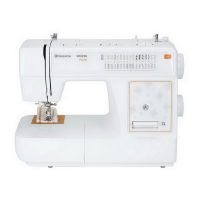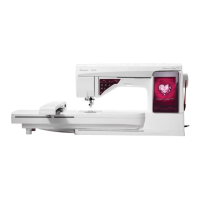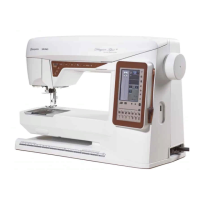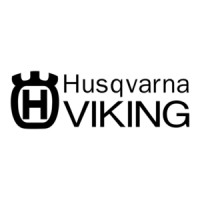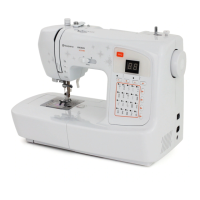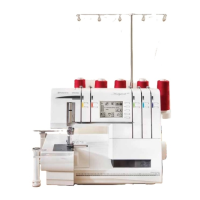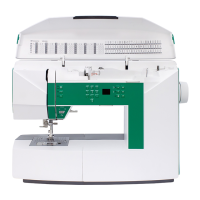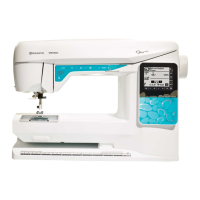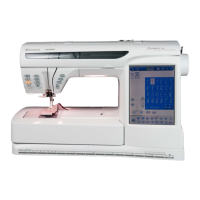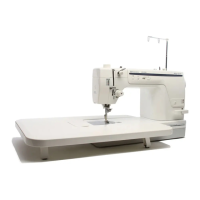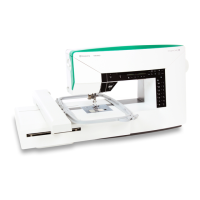Do you have a question about the Husqvarna Viking Viking Iris and is the answer not in the manual?
Safety measures to reduce the risk of electric shock when using the sewing machine.
Warnings and precautions to prevent burns, fire, electric shock, or injury to persons.
Identifies and labels the main parts of the sewing machine for user reference.
Step-by-step guide for safely removing the sewing machine from its packaging.
Instructions for properly storing the sewing machine after use.
Guide on how to connect the foot control pedal to the sewing machine.
Steps for connecting the sewing machine to an electrical power source.
Instructions on how to use the spool pins for different thread spool sizes.
Detailed steps for threading the upper thread through the machine guides.
Guide on threading the machine for use with a twin needle.
Instructions for winding bobbins with the upper thread in place.
Method for winding bobbins using a separate vertical spool pin.
Step-by-step guide for correctly placing the bobbin into the bobbin case.
Explanation of how thread tension affects stitches and how to adjust it.
Visual examples and explanations of correct and incorrect thread tension results.
How to adjust the pressure of the presser foot for different fabrics.
Guide on raising and lowering the presser foot and adjusting its lift height.
Instructions for removing and inserting a new sewing needle.
How to lower the feed teeth for free-hand work or embroidery.
Explanation of the Infodisplay screen and its indicators.
Details on adjusting stitch length, needle stop position, and sewing speed.
Covers stitch/embroidery selection, recommended feet, and Infodisplay features like mirror image.
Details on optional accessories like sensor foot and letter cards for embroidery.
How to move and rotate embroidery designs using specific buttons.
Using buttons to step through stitches and thread color changes in embroidery.
Method for checking the dimensions of an embroidery design.
Details on selecting alphabet styles, sizes, and characters using optional cards.
Lists the items included in the embroidery accessory bag.
Step-by-step guide for inserting and removing the embroidery card.
Instructions for turning on the machine and its self-test sequence for embroidery.
Information on using the embroidery booklet for design details and placement.
Guidance on selecting appropriate thread types and weights for embroidery.
Instructions for attaching and using the embroidery presser foot.
Steps to prepare and assemble the outer and inner embroidery hoops.
Guidance on placing fabric and stabilizer correctly within the hoop.
Instructions for using the template and pencil to mark fabric for embroidery.
Guide on aligning the hoop with fabric marks for accurate embroidery.
Steps for threading the machine and selecting an embroidery design.
How to initiate sewing, handle jump stitches, and cut starting thread tails.
Procedures for stopping and restarting the machine during thread color changes.
Solutions for thread breakage or running out of thread during embroidery.
Buttons for positioning, rotation, stitch advance, and color advance within embroidery.
Controls for checking size, single-color mode, and multi-menu embroidery cards.
How to mirror an embroidery design horizontally for different effects.
Guide on adjusting embroidery size using stitch length and width settings.
Steps to safely detach the embroidery unit from the sewing machine.
Instructions for attaching the embroidery unit to the sewing machine.
Steps for detaching the specialized embroidery presser foot.
Instructions for changing back to a regular presser foot.
An introduction to the available stitches and their basic applications.
Guidance on using the straight stitch for joining fabrics and seams.
Explanation of the reinforced straight stitch for durability and stretch fabrics.
How to use the stretch stitch for pliable seams on knit fabrics.
Applications of the zigzag stitch, including edging and appliqués.
Step-by-step instructions for creating various types of buttonholes.
How to use the buttonhole knife and mark buttonhole placement.
Instructions for sewing buttons onto fabric using zigzag stitch.
Method for sewing buttons with shanks using a clearance plate.
Primary uses of the straight stitch for joining fabrics without stretch.
How to adjust needle position for edge stitching and precise seams.
Technique for creating gathers using two parallel rows of stitching.
Detailed instructions for sewing a lapped zipper into garments.
Use of reinforced straight stitch for heavy fabrics and stretch seams.
Application of stretch stitch for sewing light stretch fabrics.
How to adjust stitch length and width for zigzag stitching.
Method for attaching lace edging using zigzag and satin stitches.
Applications of three-step zigzag for overcasting, mending, and finishing.
Techniques for sewing terry cloth, including finishing edges.
Using three-step zigzag for repairing worn areas of fabric.
Use of flatlock stitch for overlapped seams and decorative hems.
Instructions for folding and sewing fabric to create narrow bands.
Guide to sewing invisible hems using the blind hem stitch.
Uses of bridging stitch for joining fabric, leather, vinyl, lace, and ribbon.
How to use seam and overcast stitches for edge finishing.
Application of the overlock stitch for medium and heavy stretch fabrics.
Instructions for creating appliqués using hand look and satin stitches.
Details on using stitches 17-18 for darning and tapered designs.
Specific guidance on using the darning stitch for mending.
How to use the automatic taper stitch for monograms and embellishments.
Introduction to various decorative stitches and their examples.
Using stitch 16 with yarn for a decorative outcome.
Application of stitch 15 for creating effective decorative edges.
Using stitch 13 with a wing needle to create hemstitches.
Using the free arm for sewing trouser legs, sleeves, and darning.
Techniques for sewing thick jeans hems, including using a clearance plate.
Step-by-step guide for sewing belt loops onto garments.
Instructions for replacing the sewing machine's light bulb.
Guidance on regular cleaning and maintenance for optimal machine performance.
Steps for removing and replacing the stitch plate.
Solutions for needle breakages, unattractive stitches, and thread tension issues.
Troubleshooting for upper and bobbin thread breaks and irregular bobbin winding.
Addressing problems with fabric feeding and fabric puckering.
Resolving issues with loose stitches, incorrect stitches, and sluggish machine operation.
How to set the balance for buttonholes for optimal results.
Guidance on seeking professional help and warnings about non-original accessories.
A comprehensive index listing all topics and their corresponding page numbers for quick reference.
Confirmation of the sewing machine's adherence to relevant European directives.
Statement regarding the manufacturer's right to modify design and accessories.
| Brand | Husqvarna Viking |
|---|---|
| Model | Viking Iris |
| Category | Sewing Machine |
| Language | English |
